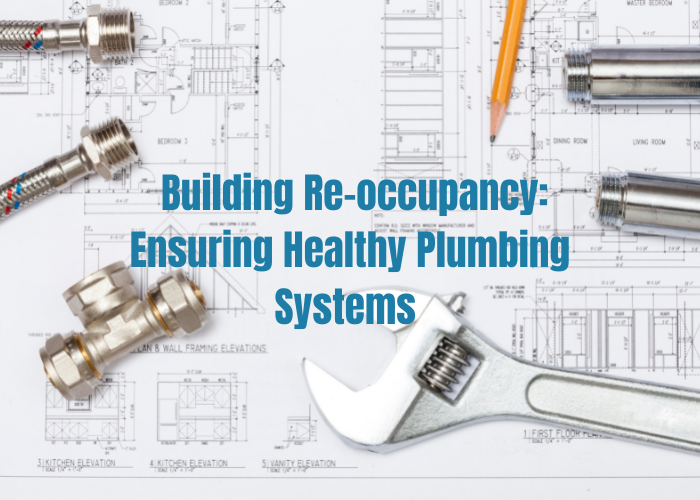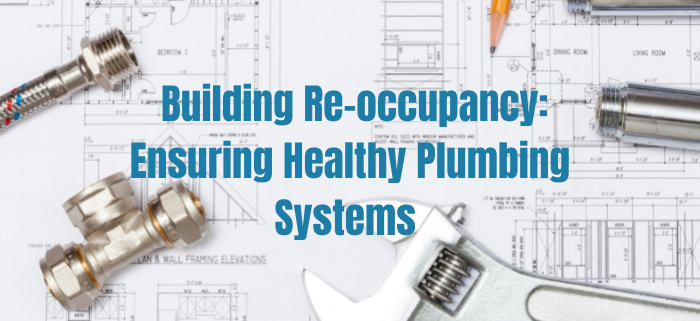Building Re-occupancy: Ensuring Healthy Plumbing Systems
 Post-pandemic, are there problems with your building’s plumbing systems? Many buildings sat empty or were minimally occupied during the recent pandemic. Because of this, they may have hidden problems. Frequently, we work with clients who are considering purchasing an unoccupied space. Are you considering purchasing a building that sat idle during an extended period of time?
Post-pandemic, are there problems with your building’s plumbing systems? Many buildings sat empty or were minimally occupied during the recent pandemic. Because of this, they may have hidden problems. Frequently, we work with clients who are considering purchasing an unoccupied space. Are you considering purchasing a building that sat idle during an extended period of time?
When a building is unoccupied, a lack of water flow in unused plumbing systems often leads to potential problems. Plumbing systems in unoccupied buildings are good candidates for evaluation and possible remediation prior to re-occupancy.
Did You Know? In 1804, Philadelphia was the first city to switch to cast iron pipes to create an intricate new system of water delivery. – History of Plumbing Timeline by PMI.
Problems with Unused Plumbing Systems
Plumbing systems are designed to accommodate moving water. This water actually keeps the pipes and fixtures cleaner and safer. Without it, waterborne germs may proliferate and people who come in contact with the water may become sick. In addition, plumbing fixtures and fittings may degrade without the benefit of water flow.
During periods of disuse, building pipes and plumbing fixtures are impacted by a variety of issues:
- Seals may dry out, causing potential future leaks when plumbing fixtures return to use.
- Valves and fittings may be damaged by the buildup of sediment and rust in corroded pipes.
- Stains may form on plumbing fixture surfaces and they may become difficult to remove later.
- The chlorine in stagnant water will degrade and contaminants may grow.
- Organisms may grow in plumbing systems that are not continuously exposed to chlorinated water. Read about waterborne germs and biofilm here.
- Lead, rust, and sediment in older, unused pipes may leach into the water when the use of plumbing systems resumes.
Evaluate Unused Plumbing Systems
If a building’s plumbing systems have been unused, they may require a little TLC.
- Contact your local licensed plumbing professional for evaluation and assistance.
- Have your water tested to ensure it is safe for use. If the water requires remediation, you may need to have the lines flushed and the water treated.
- Evaluate your pipes, fixtures, fittings, and any water-using device. Make repairs to deficient plumbing systems.
Water Safety Tips for Work and Home
The Centers for Disease Control and Prevention (CDC) offers great tips for homeowners to prevent waterborne germs at home. Many of these tips also apply to our workspaces.
Tips for Preventing Waterborne Germs:
- Flush faucet aerators and showerheads regularly.
- Clean, disinfect, and maintain devices that use water.
- Follow manufacturer’s recommendations about devices that use water.
- Set water heaters at the appropriate temperature to reduce the growth of germs.
- Flush your water heater, as recommended.
- Sign up for “boil water” advisories from public water utilities.
- Follow CDC recommendations for keeping private water sources safe.
Additional Plumbing Resources
For additional information about plumbing systems, check out these resources:
- American Society of Plumbing Engineers (ASPE)
- American Society of Sanitary Engineers (ASSE)
- Plumbing Manufacturers International (PMI)
- World Plumbing Council (WPC)
Bottom Line:
Post-pandemic or whenever your building is unused for a period of time, a lack of water flow may lead to problems in your piping, fixtures, and water quality. Consult with a plumbing expert for evaluation and remediation. Once you’re up and running again, maintain your plumbing systems for longevity and safety.



